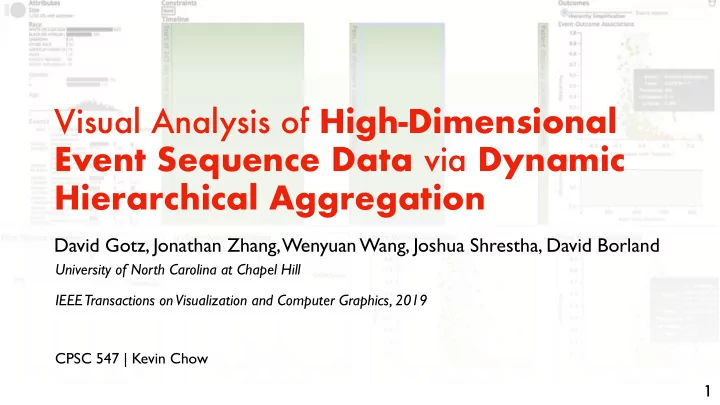

Visual Analysis of High-Dimensional Event Sequence Data via Dynamic Hierarchical Aggregation David Gotz, Jonathan Zhang, Wenyuan Wang, Joshua Shrestha, David Borland University of North Carolina at Chapel Hill IEEE Transactions on Visualization and Computer Graphics, 2019 CPSC 547 | Kevin Chow 1
Event Sequences • Time-ordered lists of discrete events • Analyze to discover patterns or rare event paths • But… real-world datasets are large and complex: • Volume and length of event sequences • High-dimensional event data 2
Volume and length of event sequences 3
Volume and length of event sequences Aggregate sequences 3
Volume and length of event sequences Aggregate sequences High-dimensional event data 3
Volume and length of event sequences Aggregate sequences High-dimensional event data Group events 3
Grouping Events • Typically, events are grouped in a pre-processing step • Requires foreknowledge and expertise about events Event type hierarchy ICD-10 Coding System I50: Heart Failure I50.2: Systolic Heart Failure I50.21: Acute Systolic Heart Failure …… 4
Grouping Events • Can’t change event groups interactively • May want multiple groupings — different levels of detail • An ideal grouping may not exist — data- and task- dependent 5
Cadence Visual Analysis for Medical Event Sequences 6
Cadence Visual Analysis for Medical Event Sequences 6
Cadence Visual Analysis for Medical Event Sequences 7
Cadence Visual Analysis for Medical Event Sequences 8
Dynamic Hierarchical Aggregation 9
Dynamic Hierarchical Aggregation 1. Determining an optimal and adjustable level of grouping events based on an informativeness score 10
Dynamic Hierarchical Aggregation 1. Determining an optimal and adjustable level of grouping events based on an informativeness score 2. Supporting navigation of the event type hierarchy with a scatter-plus-focus visualization 11
Dynamic Hierarchical Aggregation 1. Determining an optimal and adjustable level of grouping events based on an informativeness score 2. Supporting navigation of the event type hierarchy with a scatter-plus-focus visualization 3. Scenting to enable discovery of interesting event types 12
Informativeness Score • Computed for each event type j in the event type hierarchy • Measures the strength of the association between an event type and the outcome • If this patient had outcome v , did they also experience event type j ? • Based on the chi-square test statistic 13
Algorithm: Optimal Grouping Level • Goal: Determine the most informative cut through the event type hierarchy • Recursively traverse event type hierarchy • Compare informativeness score of parent with each child 14
Algorithm: Optimal Grouping Level R j = # of children more informative than parent total # of children Add j to cut if: (else, recurse) 1. No more children (leaf) 2. where 0 ≤ R ≤ 1 R j ≤ R R controls level of aggregation (larger = more aggregation) 15
Scatter-plus-Focus Scatter plot Focused dual-view 16
Scatter-plus-Focus • Challenges of overplotting! • Grey hexes hint at density of all possible event types • Marks are only event types part of informative cut • Control with slider R 17
Scatter-plus-Focus • Focuses on hierarchy of selected event type • X-axis is centred on correlation • Y-axis: determined by optimization-based layout algorithm 18
Algorithm: Optimize Layout • Cost function that balances two layout priorities : • Y-positions should be close to original in scatter view • Marks should not overlap • Two constraints: • Optimized y-positions must be within y-axis scale • Original y-position order of marks must be preserved 19
Algorithm: Optimize Layout No changes to y-positions With algorithm 20
Scenting • Shows up when exploring type hierarchy in focused view • Scent value: range of correlations to outcome in children • Size of glyph indicates magnitude of scent value 21
Evaluation • 3 medical experts: health researchers with data analysis experience • Hands-on demonstration and semi-structured interviews • Results from thematic analysis: • Training is required • Automated selection of aggregation level useful • Navigating through event type hierarchy was intuitive 22
What-Why-How Analysis What: Data Why • Tree (event type • Discover and hierarchy) produce (event type • Table (patient data) groupings) What: Derived • Optimal event grouping • Informativeness score, Scale: 5,000 patients, scent value, optimized y- 700,000 events, 10,000 positions unique event types 23
What-Why-How Analysis How: Change How: Encode • Select (mark in scatter) • Scatterplots • Color (outcome correlation) How: Facet • Overview+detail view How: Reduce (scatter-plus-focus) • Item aggregation (grouping event types) • Layering (grey hexes in • Scenting (picking event type) background) 24
Critique • Strengths • Intuitive, simple algorithms • Dealt with challenges of occlusion and distortion • Switching between views and parameter control reduces load • Generalizable to contexts other than health 25
Critique • Weaknesses/Limitations • Automated approach to aggregation may hide better custom groupings • Adding event type groups can be tedious • Reliance on tree-based event type hierarchy 26
Thank You! Visual Analysis of High-Dimensional Event Sequence Data via Dynamic Hierarchical Aggregation 27
28
Recommend
More recommend